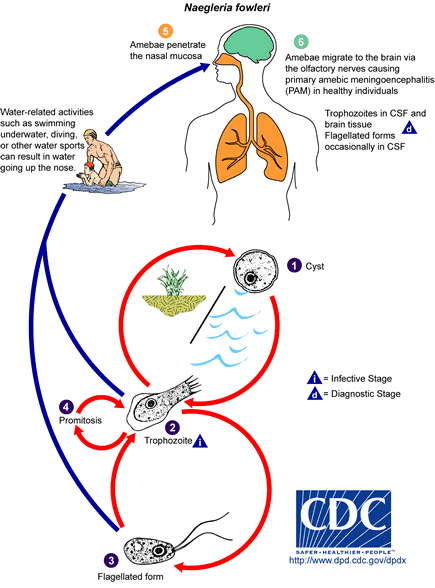Officials with the Sindh health ministry confirmed an additional death due to infection with the “brain-eating amoeba”, Naegleria fowleri on Tuesday, according to multiple media accounts.

The victim of the lethal amoeba is a 29-year-old teacher from Karachi. This is the third such case in Sindh and second in Karachi in 2017 to date.
It is suspected that he contracted N. fowleri performing ablution.
Pakistan reported 5 deaths in 2016 following double digit deaths in 2015 and 2014 (HERE and HERE).
Naegleria fowleri (commonly referred to as the “brain-eating amoeba”), is a microscopic amoeba which is a single-celled living organism. It can cause a rare and devastating infection of the brain called primary amebic meningoencephalitis (PAM). The amoeba is commonly found in warm freshwater such as lakes, rivers, ponds and canals.
Infections can happen when contaminated water enters the body through the nose. Once the amoeba enters the nose, it travels to the brain where it causes PAM (which destroys brain tissue) and is usually fatal. Infections usually occur when it is hot for prolonged periods of time, which results in higher water temperatures and lower water levels.
Naegleria fowleri infections are rare. Most infections occur from exposure to contaminated recreational water. Cases due to the use of neti pots and the practice of ablution have been documented.
The practice of ablution is included in Yogic, Ayurvedic, and Islamic traditions. Within the Islamic faith, ritual nasal rinsing is included in a cleansing process called “wudu” or “ablution.” It is usually performed several times a day in preparation for prayer, according to the Centers for Disease Control and Prevention.
LISTEN: Naegleria fowleri: An interview with Dr Jennifer Cope
You cannot be infected with Naegleria fowleri by drinking contaminated water and the amoeba is not found in salt water.
Initial symptoms of PAM usually start within 1 to 7 days after infection. The initial symptoms may include headache, fever, nausea, or vomiting. Other symptoms can include stiff neck, confusion, loss ofbalance, seizures, and hallucinations. After the start of symptoms, the disease progresses rapidly.
For more infectious disease news and information, visit and “like” the Infectious Disease News Facebook page
Related:
- Neti pots, Naegleria and you
- Miltefosine and the 4th Naegleria fowleri survivor: Talking with Profounda CEO, Todd MacLaughlan
- Naegleria fowleri drug research: An interview with Dennis Kyle, PhD


